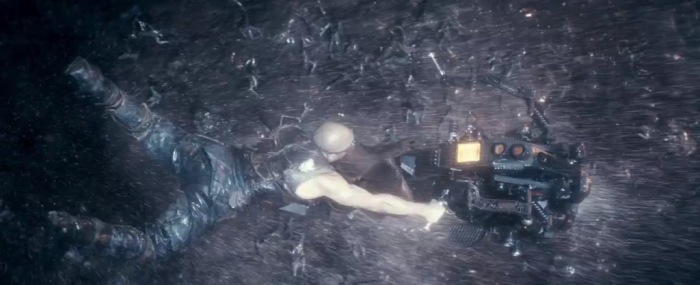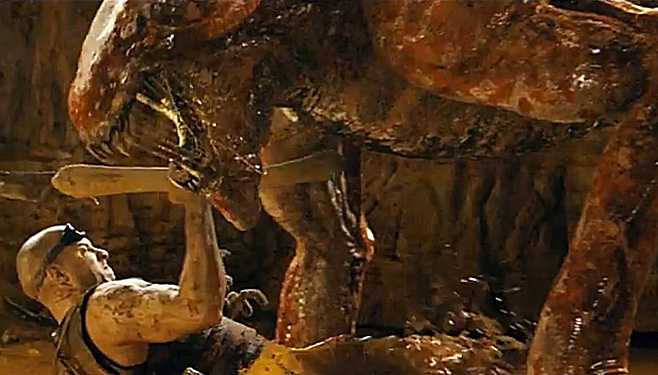Recently I listened to another good podcast from The RPG Academy on ‘re-skinning’. Specifically these are about re-skinning a ‘monster’ as an environmental threat (E.g. a Storm Giant, as a literal (magical) storm). They also reference the Fate Fractal mechanics, in the manner of giving hostile environments mechanical values (Stress tracks) to overcome. This was a good podcast, and it gave me some other ideas about how this could be done…
The podcast/Fate rules are using the word ‘environmental’ in a literal sense. As a writer (including screenplays) I immediately thought of an environmental threat as simply a way to say that a threat is no longer immediate and in-your-face, and that it has now been confronted, and at least partially understood, to the point that understanding it is now your best defence against it. Also, it hasn’t gone away, it has… melted into the environment.
Consider the first and third movies in the Riddick series – ‘Pitch Black’ and ‘Riddick’. In both instances Riddick confronts the ‘monster’, develops an understanding of it, and then can deal with it as environmental threat that can be out-thought, not just out-fought.
MONSTER
v.
THREAT

There are no gaming rules out there that I know of that handle this evolving scenario in this particular way – once a threat, always a threat! is how most games tend to operate.
Using D&D 5e as an example, consider this alternate statblock for a generic monster, which has the following components:
- Standard statblock (numbers)
- Environmental skin (text)
- Understanding threshold (values)
- Environmental defence (Stat or Skill)
In the immortal words of Grandmaster-Flash ‘let me break it down for you, sir…’
Standard statblock (numbers): Your standard 5e statblock (or any other game system for that matter)
Environmental skin (text): A short description of how the monster will operate/look/feel once it has been understood. Fluff mostly, but still very important.
Understanding threshold (values): The mechanical requirement that has to be met in order to understand the monster. It can be listed in terms such as ‘number of encounters’, and/or ‘numbers faced’, and/or ‘numbers defeated’, and or a Skill degree-of-success requirement (e.g. Lore/Knowledge[Monster] 3 successes). NOTE that each character will have to come to their own understanding of the monster; although those who already have that understanding may assist the relevant Skill checks of their friends.
Environmental defence (Stat or Skill): This is the Stat or Skill that is used to ‘manage’ the monster once it is understood. This need not be tested each combat-action, but on an expanding/contracting timescale where relative success expands the time until the next test is required, and relative failure reduces the time until the next test. A relative failure also indicates that the monster gets to make all its attacks, and inflict damage as per normal.
‘What about defeating the environmental threat?’ I here you ask… Well that is where my definition of an environmental threat differs from the podcast/Fate Fractal version. You cannot defeat it as an environmental threat – it still must be faced and defeated as a monster!
Pros:
- Will give added weight to Lore/Knowledge based characters, while not detracting from the monster.
- Lingering threats can sustain the mood/feel of the game very well.
- All the mechanics is vested in the players, not the GM, which incidentally creates a micro-reward for each monster that is mastered!
Cons:
- I’m perfectly fine with the concept of an un-killable threat, although traditional ‘hit it until its dead’ players might balk at the idea.
I would really like to hear your comments and feedback, and as always, your mileage may vary…

